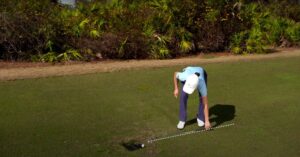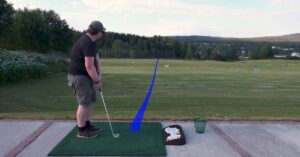What Club Would Most Golfers Likely Hit From 100 Yards?
Golf requires precision and strategy. Holes demand specific clubs for challenges like bunkers, slopes, and 100-yard shots. The right club choice greatly impacts your game.
For a 100-yard shot, golfers typically use a pitching wedge, a 9-iron, or a gap wedge. These clubs provide the necessary precision, control, and versatility to handle this distance effectively. Club selection may vary based on individual skill and comfort level.
Before delving into the specifics of why these clubs are apt for the task, it’s crucial to discuss the factors that need to be considered. Let’s dive in!

Things to Consider Before Taking Shot from 100 Yards
A variety of factors influence the club’s choice for a specific shot. It’s not merely the distance that dictates the club selection, but several other elements also come into play.
Lie of the Ball
The first thing a golfer should consider is the lie of the ball. Is it on the fairway or in the rough?
Is the lie uphill, downhill, sidehill, or in a divot? The ball’s lie can significantly impact the shot’s trajectory and distance, and hence the choice of club.
Wind Conditions
Wind conditions can considerably affect the flight of the ball. A strong headwind might necessitate a lower-lofted club to keep the ball flight lower, while a tailwind might allow for a higher-lofted club.
Golfer’s Skill Level
The golfer’s skill level and comfort with specific clubs should also be taken into account.
A beginner might not be able to get the same distance with a club as an experienced golfer can.
Now, let’s examine the appropriateness of the clubs usually picked for a 100-yard shot.
What Club Do Most Golfers Typically Use For A 100-Yard Shot?
Most golfers would likely hit a pitching wedge or a 9-iron from 100 yards. Others may prefer to use a gap wedge or a sand wedge.
These clubs are particularly favored for this distance due to their precision, control, and versatility.
For beginner golfers, the 9-iron tends to be a popular choice for 100-yard shots, as it can typically achieve a distance of 95-105 yards, which can extend to 110 yards with the assistance of the wind.
Pitching Wedge for Precision and Control at 100 Yards

The pitching wedge is a popular choice among golfers when hitting from 100 yards due to its specific design features that offer precision and control.
With an average loft ranging from 44 to 48 degrees, the pitching wedge provides an ideal trajectory for the 100-yard shot.
The loft helps create a higher ball flight, allowing the golfer to clear any potential hazards or obstacles on the course.
Additionally, the pitching wedge’s loft allows for better control over the distance and direction of the shot.
It provides a reliable option for golfers who aim to hit the ball with accuracy and consistency.
The shorter shaft length of the pitching wedge compared to longer irons also contributes to better control and a more compact swing, making it easier for golfers to make solid contact with the ball.
The familiarity and versatility of the pitching wedge also make it a preferred club choice for 100-yard shots.
Most golfers are accustomed to using the pitching wedge for various short-game shots, such as chipping and pitching around the greens.
This familiarity translates into confidence and comfort when using the club for a 100-yard approach shot.
Golfers can trust the pitching wedge to deliver consistent results and a predictable ball flight, enhancing their chances of hitting the green or getting close to the target.
9-Iron for Overcoming Obstacles with Ease
When faced with a 100-yard shot that requires clearing obstacles like water hazards or sand bunkers, many golfers turn to the 9-iron.
The 9-iron is known for its higher loft, typically ranging from 40 to 44 degrees, which helps generate a steep trajectory.
This increased height can assist in carrying the ball over hazards and landing it softly on the green.
The 9-iron’s loft also contributes to better distance control, allowing golfers to adjust the carry and roll of the ball to suit the specific conditions of the shot.
Its shorter shaft length and slightly larger clubhead compared to the pitching wedge provide a good balance between control and power.
Golfers can rely on the 9-iron to deliver consistent results, even from challenging lies or uneven terrain.
Moreover, the 9-iron is often regarded as one of the more forgiving clubs in a golfer’s bag.
Its design and weight distribution make it easier to strike the ball cleanly, even for players with less-than-perfect ball-striking skills.
This forgiveness factor is particularly valuable when attempting a 100-yard shot, where precision and accuracy are crucial.
The Gap Wedge for Precision and Distance Combination

For golfers seeking a combination of precision and distance control at the 100-yard mark, the gap wedge proves to be a valuable option.
The gap wedge, also known as the utility or approach wedge, typically has a loft ranging from 50 to 52 degrees.
This loft allows golfers to achieve the necessary distance while maintaining control over the ball’s flight.
The gap wedge’s loft provides a slightly lower trajectory compared to the pitching wedge, enabling the golfer to manage the wind and control the ball’s flight better.
It offers the opportunity to hit a controlled, penetrating shot that can stop quickly on the green, providing the golfer with a better chance for a birdie or par.
Another advantage of the gap wedge is its versatility in various situations around the course.
It can be effectively used not only for 100-yard approach shots but also for shorter greenside shots that require precision and control.
The ability to use the gap wedge for a wide range of shots gives golfers added confidence and consistency when facing different scenarios on the course.
Club Selection of Professional Golfers for 100-Yard Shots
Determining the club a golfer would likely hit from 100 yards heavily relies on the individual’s skill level, strength, and strategy.
Most amateur golfers would typically use a pitching wedge or a 9-iron for this distance, while professional golfers might select a gap wedge, sand wedge, or even a shorter club, depending on the situation and their unique swing characteristics.
For example, Tiger Woods, one of the most successful golfers of all time, has been known to hit a full-swing sand wedge from 100 yards. However, this is a reflection of his exceptional swing speed and control.
Phil Mickelson, another professional golfer renowned for his short game, may use a lob wedge from this distance, particularly when he needs the ball to stop quickly on the green.
There are certainly exceptions to these norms. Bryson DeChambeau, who is known for his unique scientific approach to the game and incredible swing speed, might use a club with less loft, like a gap wedge or even a 9-iron from 100 yards.
His ability to generate high ball speeds allows him to use less lofted clubs for the same distances compared to other players.
In the end, club selection from 100 yards will vary depending on a range of factors, including the golfer’s skill level, the wind, course conditions, and even pressure situations within a round.
The key is to understand your own capabilities and choose the club that gives you the best chance of success.
Final Words
Selecting the correct club for a 100-yard shot involves strategic thinking, considering factors like ball lie, wind, and skill level.
Many golfers opt for a pitching wedge, 9-iron, or gap wedge due to their accuracy and adaptability.
However, the ideal choice should align with the golfer’s confidence and comfort. Remember, golf is both mental and physical.






